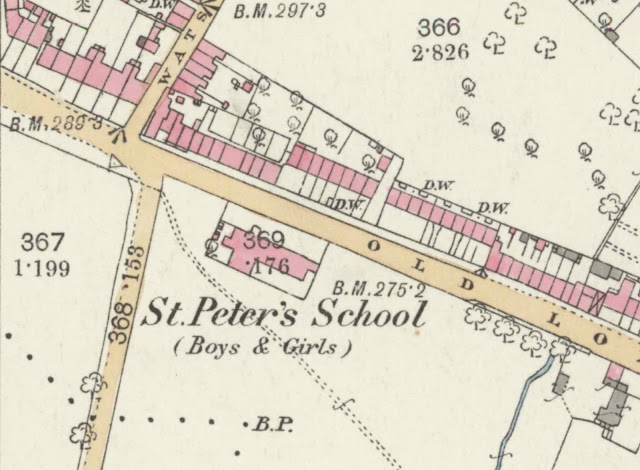You may be surprised when opening this page. Is this the correct link? Rest assured; from this post the top banner has finally been replaced to match the banner of the website – I finally got there!
Before moving on to formal systems of education, there is one further photograph which belongs in the previous post on the subject of private schools. Mention was made of Manor Lodge School in Upper Lattimore Road. St Albans Museums does have a small monochrome photo of the school, but since the building survives I've included instead a picture of the house today as you might come across it while walking along the footpath towards Hatfield Road and just before reaching the Friends Meeting House.
 |
| This house used to be Manor Lodge School; located in Upper Lattimore Road. COURTESY GOOGLE STREETVIEW |
Until the 1870s there was little of relevance to our East End in the availability of education for children, there were, after all, so few families living in that part of the parish of St Peter, except those in isolated hamlets, farm houses and cottages of a few agricultural labourers. The education of girls was mainly home learned; boys worked on farms, or may have made their way to St Albans and been employed in workshops where there might have been an industrial school. Less of a school; more of the industry. However, it can't be denied, a system had grown slowly and spasmodically. It would be pertinent to explore its beginnings and how it relates to current school sites throughout the city.
 |
| Surviving British School at Hitchin, today a thriving education museum. COURTESY THE BRITISH SCHOOLS MUSEUM |
Within three years of the formation of British Schools the National Society for Promoting the Education of the Poor was launched and typically set up schools in parish churches and were generically called National Schools. Their intentions were to further the principles of the Church of England, and they were able to benefit from a larger number of available buildings – the parish churches and their church halls. They also found it easier to attract state funds, and to operate their schools on lower costs.
So, let's discover the range of National schools in St Albans.
The wide, sprawling and mainly rural parish of St Peter had its school for up to 85 infants in Bernard Street. It was typical of early schools tucked away in the side streets of the town centre; a single room in which the children were educated or "looked after". It is likely that the prime motive was not so much the provision of an education but to free up mothers for useful employment. Incidentally, the term "infant" did not have the precise meaning the word does today; older and younger children were sometimes accepted as well.
 |
| The entrance to the former St Peter's School. The gates are today named Old Priory Park. Priory Park School, buildings extant, was further along Old London Road. |
The parish's main school building was on the corner of Old London Road and Cottonmill Lane and opened for 205 pupils in 1850. Ad hoc accommodation may have been utilised at the church in St Peter's Street before the separate school could be afforded. As we shall discover in a later post, a separate school was later created for children living beyond the city limit, but in the early days distance was the main obstacle in attending the parish church National school. The parish church school was, as was not uncommon, restricted to girls when first opened. The current St Peter's JMI now operates from modern buildings nearby.
What of the other city parishes?
St Stephen's, like St Peter's was responsible for a large rural parish, some of which spread towards our East End, and its urban population was small. There were around 60 pupils on roll in 1890, reducing to around 30 in 1923. The opening of a school, possibly on a different site from Watford Road, is not known about.
St Michael's can trace its first parish school, in the church, back to 1811, accommodating girls whose families lived on the Gorhambury estate. A separate building was opened next to the church in 1854, and it took until 1876 for a separate National building, nearer to the river, to open for boys.
 |
| The crowded site between Dagnal (with one l) Street and Spencer Street in 1872. COURTESY NATIONAL LIBRARY OF SCOTLAND |
Abbey parish occupies the smallest acreage but possesses the greatest population density. In the narrow and crowded Cross Street close to Dagnall Street opened Cross Street Infants which opened in 1836 accommodating 120 children. It is therefore possible that abbey-owned building was utilised before then. Spicer Street provided accommodation from the 1840s for junior and senior girls and boys, amounting to over 400 children on a very constrained site. It was not until the post-war period that new buildings were provided in Grove Road.
In recognising the role being played by the National and British organisations the state formalised a system of maintenance grants to schools from the 1830s. These were dependent on common standards being set and met.
Shortly, we will enter the period when Government began to formulate laws and lay the foundation for compulsory education. During February we will identify the locations of Board schools to which children would attend; and the transformation into Elementary school.


No comments:
Post a Comment